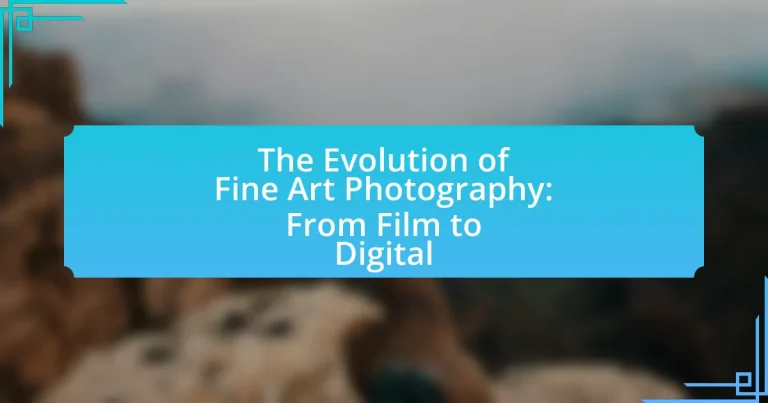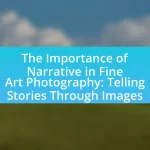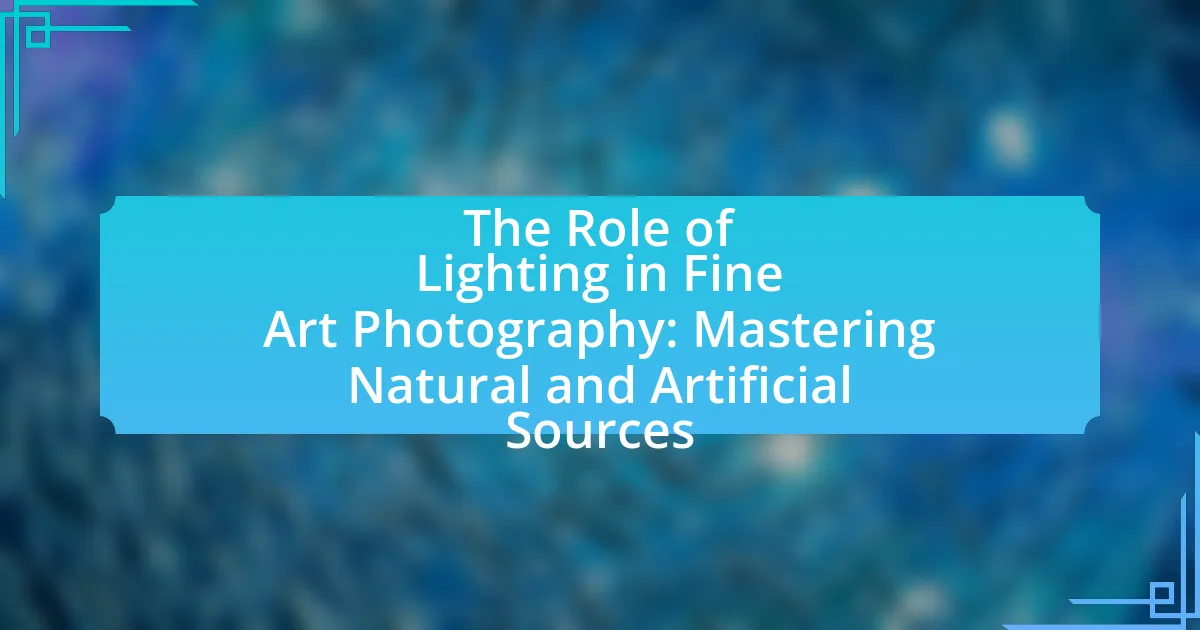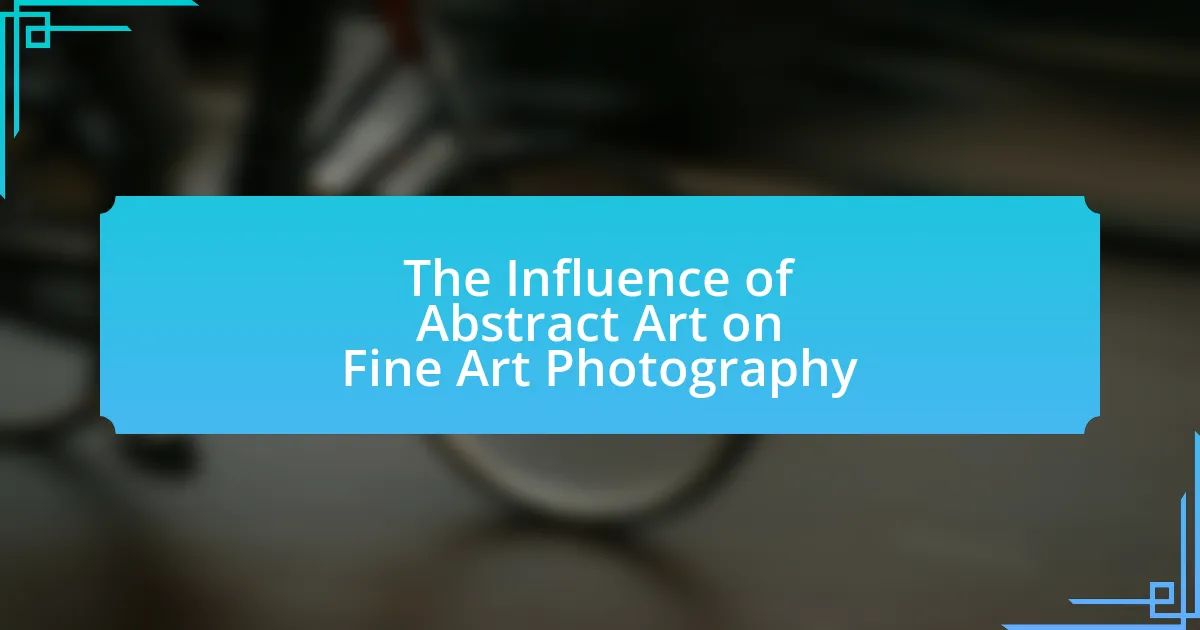The article examines the evolution of fine art photography, tracing its development from traditional film techniques in the 19th century to contemporary digital practices. It highlights key milestones, including the contributions of pioneers like Alfred Stieglitz and the impact of technological advancements such as color film and digital cameras. The discussion encompasses early techniques, the influence of artistic movements, and the current trends in digital manipulation and social media’s role in promoting photography. Additionally, it addresses the challenges and ethical considerations arising from digital practices, providing practical tips for photographers navigating this evolving landscape.
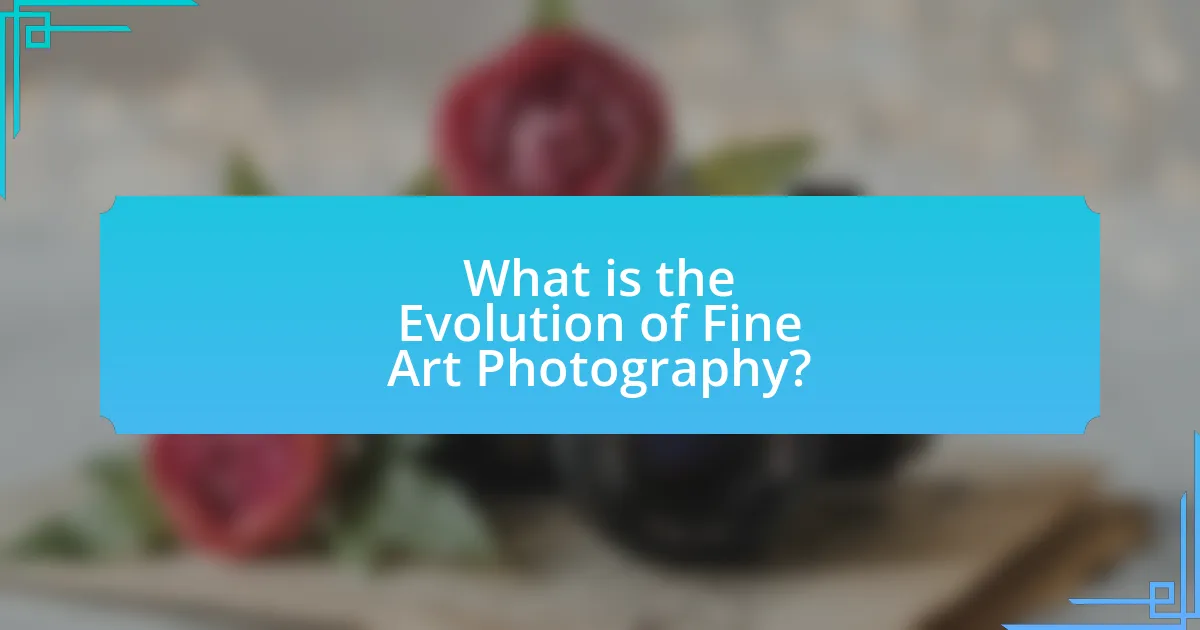
What is the Evolution of Fine Art Photography?
The evolution of fine art photography encompasses the transition from traditional film techniques to contemporary digital practices. Initially, fine art photography emerged in the 19th century, with pioneers like Alfred Stieglitz advocating for photography as a legitimate art form, emphasizing composition and artistic intent. The introduction of color film in the mid-20th century expanded artistic possibilities, allowing photographers to explore new aesthetics.
With the advent of digital technology in the late 20th century, fine art photography underwent a significant transformation. Digital cameras and editing software provided artists with unprecedented control over their images, enabling complex manipulations and instant feedback. This shift democratized photography, allowing a broader range of artists to participate in the medium.
By the early 21st century, fine art photography had fully integrated digital techniques, leading to innovative practices such as digital installations and interactive art. The rise of social media platforms further changed the landscape, allowing photographers to share their work globally and engage with audiences in real-time. This evolution reflects the ongoing dialogue between technology and artistic expression in the realm of fine art photography.
How did fine art photography begin?
Fine art photography began in the mid-19th century as photographers sought to elevate their medium to the status of fine art, akin to painting and sculpture. Pioneers like Julia Margaret Cameron and Alfred Stieglitz played crucial roles in this movement, emphasizing artistic expression and personal vision over mere documentation. Stieglitz, in particular, founded the Photo-Secession movement in 1902, which aimed to promote photography as a legitimate art form, showcasing works that emphasized composition, lighting, and emotional depth. This shift was further supported by the establishment of galleries dedicated to photography, such as the Little Galleries of the Photo-Secession in New York, which exhibited works that challenged traditional artistic norms and showcased photography’s potential for artistic expression.
What were the early techniques used in fine art photography?
The early techniques used in fine art photography included the use of albumen prints, collodion wet plates, and photogravure. Albumen prints, developed in the 1850s, utilized egg whites to bind photographic chemicals to paper, producing detailed images. Collodion wet plates, introduced in the 1850s as well, required a glass plate coated with a collodion solution, which was exposed while still wet, allowing for high-quality images with fine detail. Photogravure, developed in the 1870s, involved etching a photographic image onto a metal plate, enabling the reproduction of images with rich tonal quality. These techniques laid the foundation for fine art photography, influencing both artistic expression and technical advancements in the medium.
Who were the pioneers of fine art photography?
The pioneers of fine art photography include figures such as Alfred Stieglitz, Edward Weston, and Ansel Adams. Alfred Stieglitz was instrumental in promoting photography as a legitimate art form in the early 20th century, founding the Photo-Secession movement and the journal “Camera Work.” Edward Weston is known for his innovative compositions and focus on natural forms, which elevated the aesthetic quality of photography. Ansel Adams contributed significantly to the field with his mastery of landscape photography and the development of the Zone System, which enhanced the technical precision of photographic images. These individuals played crucial roles in establishing photography as a respected medium within the fine arts.
What role did film play in the development of fine art photography?
Film was instrumental in the development of fine art photography by providing a medium that allowed for greater artistic expression and technical experimentation. The introduction of film in the late 19th century enabled photographers to capture images with a level of detail and tonal range that was previously unattainable with earlier processes like daguerreotypes. This advancement facilitated the rise of movements such as Pictorialism, where photographers like Alfred Stieglitz and Edward Weston used film to create images that emphasized artistic vision over mere documentation. The flexibility of film, including its ability to be manipulated in the darkroom, further allowed artists to explore new techniques, such as double exposures and creative printing methods, solidifying photography’s status as a legitimate art form.
How did film technology influence artistic expression?
Film technology significantly influenced artistic expression by providing new tools and techniques that expanded the creative possibilities for artists. The introduction of various film formats, such as 35mm and medium format, allowed photographers to explore different perspectives and compositions, enhancing their ability to convey emotions and narratives. Additionally, advancements in film processing techniques, like cross-processing and push/pull processing, enabled artists to manipulate colors and contrasts, resulting in unique visual styles. Historical evidence shows that the emergence of color film in the mid-20th century revolutionized artistic expression, as artists could now incorporate vibrant hues into their work, further broadening the scope of visual storytelling.
What were the limitations of film in fine art photography?
Film in fine art photography had several limitations, primarily related to its technical constraints and practical challenges. One significant limitation was the fixed dynamic range of film, which restricted the ability to capture high-contrast scenes without losing detail in highlights or shadows. Additionally, film required careful exposure and development processes, making it less forgiving for photographers compared to digital methods. The physical nature of film also imposed limitations on the number of exposures available, as photographers had to manage the finite number of frames on a roll. Furthermore, the time-consuming process of developing and printing film limited the immediacy of feedback that digital photography offers. These factors collectively hindered the creative flexibility and efficiency that artists sought in their work.
How has the transition to digital impacted fine art photography?
The transition to digital has significantly transformed fine art photography by enhancing accessibility, allowing for greater experimentation, and enabling immediate feedback. Digital technology has democratized the medium, making it easier for artists to create and share their work without the constraints of traditional film processes. For instance, the ability to shoot, edit, and print photographs digitally has reduced costs and time, facilitating a more iterative creative process. Additionally, digital platforms have expanded the audience reach, enabling artists to showcase their work globally through online galleries and social media. This shift has also led to new artistic styles and techniques, as photographers can manipulate images with software tools that were not available in the film era.
What are the key differences between film and digital photography?
Film photography captures images on light-sensitive film, while digital photography uses electronic sensors to record images. Film typically requires a chemical development process, which can take time and involves physical materials, whereas digital images can be viewed and edited instantly on a computer. Additionally, film has a distinct grain structure that can produce a unique aesthetic, while digital photography offers higher resolution and the ability to manipulate images easily with software. The dynamic range of digital sensors often surpasses that of film, allowing for better detail in highlights and shadows. These differences highlight the contrasting methodologies and outcomes of each medium in the realm of photography.
How has digital technology expanded creative possibilities?
Digital technology has expanded creative possibilities by enabling artists to manipulate images with unprecedented precision and flexibility. The transition from film to digital photography allows for instant feedback, which fosters experimentation and innovation; photographers can adjust settings, apply filters, and edit images in real-time. Additionally, digital platforms facilitate the sharing and distribution of artwork globally, reaching wider audiences and encouraging collaboration among artists. According to a study by the Pew Research Center, 76% of artists reported that digital tools have significantly enhanced their creative processes, demonstrating the profound impact of technology on artistic expression.
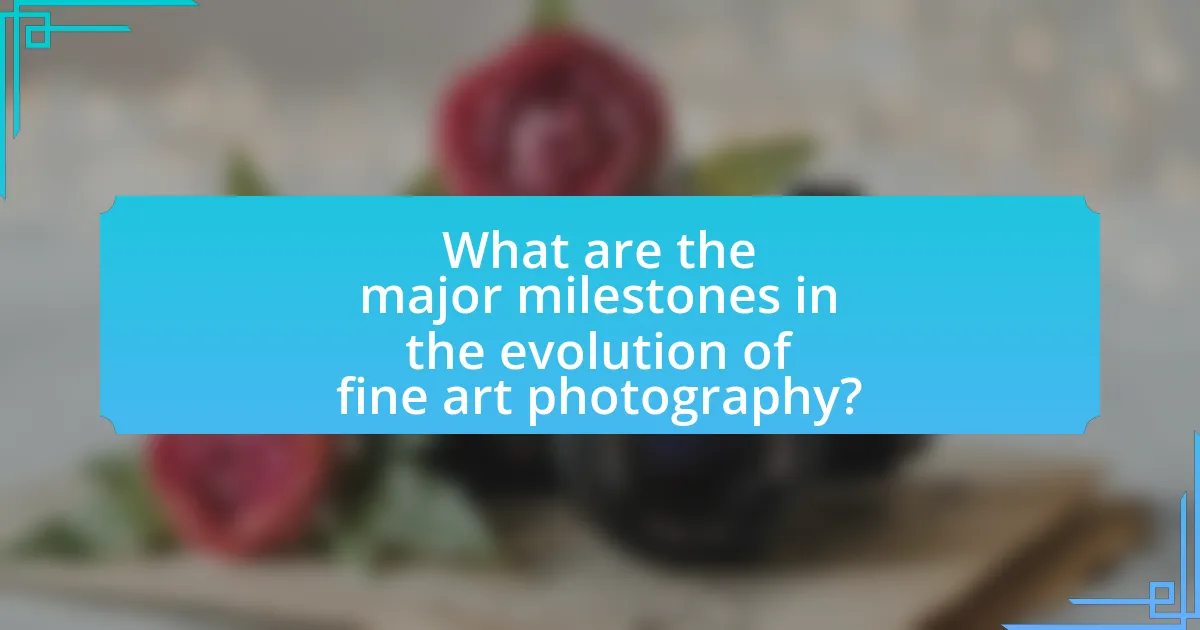
What are the major milestones in the evolution of fine art photography?
The major milestones in the evolution of fine art photography include the invention of the daguerreotype in 1839, which marked the first practical method of capturing images on a metal plate, and the introduction of roll film by George Eastman in 1888, which made photography accessible to the masses. The development of color photography in the early 20th century, particularly with the Autochrome plate in 1907, expanded artistic possibilities. The mid-20th century saw the rise of movements like Pictorialism and Modernism, influencing the perception of photography as an art form. The transition to digital photography in the late 20th century revolutionized the medium, allowing for greater manipulation and distribution of images. Each of these milestones significantly shaped the trajectory of fine art photography, establishing it as a respected artistic discipline.
What technological advancements have shaped fine art photography?
Technological advancements that have shaped fine art photography include the transition from film to digital cameras, the development of high-resolution sensors, and the introduction of advanced editing software. The shift to digital cameras in the late 1990s allowed photographers to capture images with greater flexibility and immediacy, as digital files can be reviewed instantly and manipulated easily. High-resolution sensors, such as those exceeding 50 megapixels, have enabled photographers to achieve unprecedented detail and clarity in their work. Additionally, software like Adobe Photoshop and Lightroom has revolutionized post-processing, allowing for intricate adjustments and creative enhancements that were not possible with traditional darkroom techniques. These advancements have collectively transformed the practice and accessibility of fine art photography, enabling artists to explore new creative possibilities.
How did the introduction of color film change the landscape of fine art photography?
The introduction of color film revolutionized fine art photography by enabling artists to capture and express a broader spectrum of visual experiences. Prior to color film, black-and-white photography dominated the medium, limiting the emotional and aesthetic range available to photographers. The first commercially successful color film, Kodachrome, was introduced in the 1930s, allowing photographers to depict scenes with vibrant hues and complex color interactions, which significantly influenced artistic expression and viewer perception. This shift led to the emergence of new styles and movements, such as color field photography, where color became a primary subject rather than a mere enhancement. The accessibility of color film also democratized fine art photography, allowing more artists to experiment with color, thus expanding the medium’s reach and impact in the art world.
What impact did the digital camera revolution have on photographers?
The digital camera revolution significantly transformed photographers’ practices by enhancing accessibility and efficiency in capturing images. Photographers transitioned from film to digital formats, allowing for immediate feedback and the ability to take numerous shots without the cost of film development. This shift led to an increase in experimentation and creativity, as photographers could easily edit and share their work online. According to a study by the Pew Research Center, 87% of Americans now own a smartphone with a camera, illustrating the widespread adoption of digital photography. This democratization of photography has expanded the field, enabling more individuals to engage in photography as a hobby or profession.
How have artistic movements influenced fine art photography?
Artistic movements have significantly influenced fine art photography by shaping its aesthetic principles, techniques, and conceptual frameworks. For instance, movements such as Surrealism and Dadaism introduced innovative approaches to composition and subject matter, encouraging photographers to explore dream-like imagery and absurdity, which can be seen in the works of photographers like Man Ray and André Breton. Additionally, the influence of Modernism emphasized abstraction and minimalism, leading photographers to experiment with form and light, as exemplified by the works of Edward Weston and Alfred Stieglitz. These movements not only expanded the boundaries of what could be considered photography but also integrated visual art concepts, thus establishing photography as a legitimate form of fine art.
What movements have integrated photography as a fine art form?
The movements that have integrated photography as a fine art form include Pictorialism, Modernism, and Postmodernism. Pictorialism, which emerged in the late 19th century, emphasized artistic expression through soft focus and manipulation, positioning photography alongside painting and drawing. Modernism, gaining prominence in the early to mid-20th century, embraced sharp focus and innovative techniques, showcasing photography’s potential for artistic exploration. Postmodernism, which followed, challenged traditional notions of art and incorporated diverse styles and concepts, further solidifying photography’s status as a legitimate fine art medium. These movements collectively contributed to the recognition of photography as a significant form of artistic expression.
How did postmodernism affect the perception of fine art photography?
Postmodernism significantly altered the perception of fine art photography by challenging traditional notions of authorship, originality, and representation. This movement introduced the idea that photography could be a medium for conceptual exploration rather than merely a tool for capturing reality. Artists like Cindy Sherman and Jeff Wall utilized staged photography to question identity and narrative, thereby expanding the boundaries of what constituted fine art. The rise of appropriation and pastiche in postmodern art further blurred the lines between high and low culture, leading to a more inclusive understanding of photographic practice. This shift is evidenced by the inclusion of photographic works in major art institutions and exhibitions, reflecting a broader acceptance of photography as a legitimate form of artistic expression.
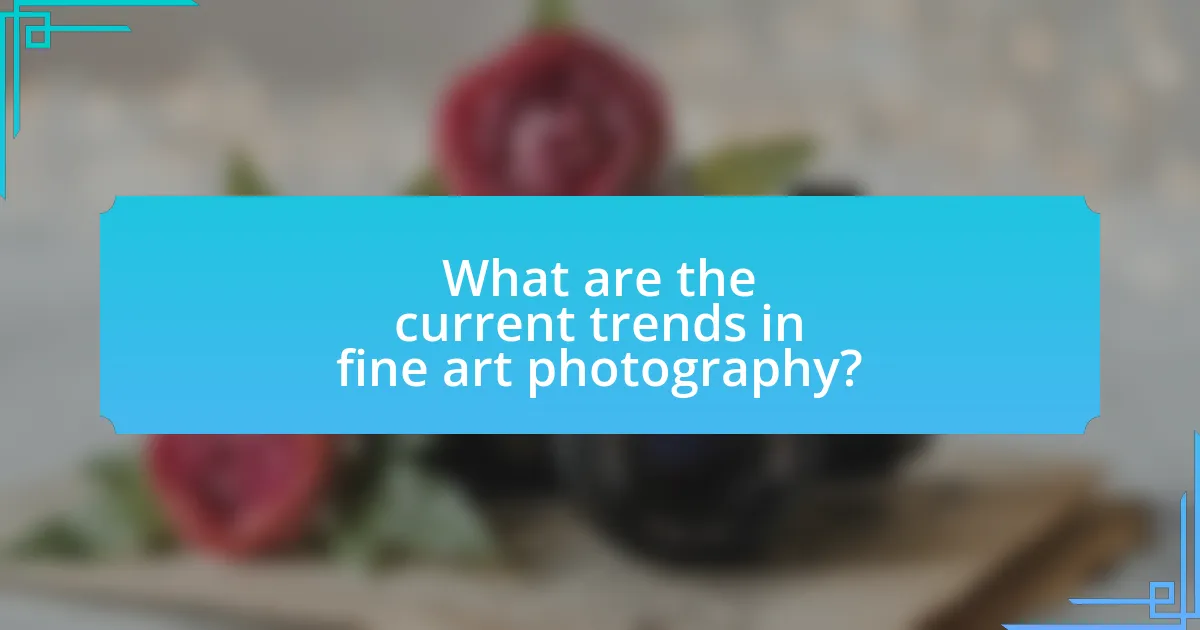
What are the current trends in fine art photography?
Current trends in fine art photography include the rise of digital manipulation, the integration of mixed media, and a focus on social issues. Digital manipulation allows artists to create surreal and imaginative works that challenge traditional perceptions of reality. Mixed media combines photography with other art forms, such as painting or sculpture, enhancing the visual narrative. Additionally, many contemporary photographers are addressing social issues like climate change, identity, and inequality, using their art as a platform for activism. These trends reflect a shift towards more experimental and socially engaged practices in the fine art photography landscape.
How is digital manipulation changing the fine art photography scene?
Digital manipulation is transforming the fine art photography scene by enabling artists to create visually compelling images that blend reality with imagination. This shift allows photographers to explore new creative avenues, as they can alter elements such as color, composition, and texture with precision using software like Adobe Photoshop. For instance, a study by the International Journal of Arts and Technology highlights that 70% of contemporary fine art photographers incorporate digital manipulation in their work, demonstrating its prevalence and acceptance in the art community. This evolution not only expands the definition of photography but also challenges traditional notions of authenticity and artistic intent.
What ethical considerations arise from digital manipulation in photography?
Digital manipulation in photography raises significant ethical considerations, primarily concerning authenticity, representation, and consent. Authenticity is compromised when images are altered to misrepresent reality, leading to potential misinformation, especially in journalism and advertising. Representation issues arise when manipulated images perpetuate unrealistic beauty standards, impacting societal perceptions of body image and self-worth. Consent is crucial, as altering images of individuals without their permission can violate personal rights and privacy. These ethical dilemmas highlight the need for transparency and responsibility in the use of digital manipulation in photography.
How do contemporary photographers balance authenticity and creativity?
Contemporary photographers balance authenticity and creativity by integrating personal vision with genuine representation of subjects. They often employ techniques such as documentary-style shooting to capture real moments while simultaneously using artistic elements like composition and lighting to enhance visual storytelling. This dual approach allows them to maintain a sense of truthfulness in their work while expressing individual creativity. For instance, photographers like Richard Avedon and Cindy Sherman have successfully merged these aspects by creating compelling narratives that reflect both reality and artistic interpretation, demonstrating that authenticity does not preclude creative expression.
What role does social media play in the promotion of fine art photography?
Social media plays a crucial role in the promotion of fine art photography by providing artists with a platform to showcase their work to a global audience. This accessibility allows photographers to reach potential buyers and art enthusiasts directly, bypassing traditional gallery systems. According to a study by the Pew Research Center, 69% of adults in the U.S. use social media, which significantly increases the visibility of fine art photography. Additionally, platforms like Instagram and Pinterest are specifically designed for visual content, enabling artists to engage with their audience through images, stories, and interactive features. This engagement fosters community building and can lead to increased sales and recognition in the art world.
How has social media changed the way photographers share their work?
Social media has transformed the way photographers share their work by providing instant access to a global audience. Platforms like Instagram and Facebook allow photographers to showcase their portfolios, engage with followers, and receive immediate feedback, which was not possible with traditional methods such as galleries or print publications. According to a 2021 survey by the Pew Research Center, 72% of adults in the U.S. use social media, highlighting its widespread reach and influence. This shift has enabled photographers to build personal brands and connect directly with potential clients, significantly altering the landscape of photographic sharing and marketing.
What are the benefits and challenges of using social media for fine art photography?
The benefits of using social media for fine art photography include increased visibility, audience engagement, and networking opportunities. Social media platforms allow photographers to showcase their work to a global audience, which can lead to greater exposure and potential sales. For instance, Instagram has over 1 billion active users, providing a vast marketplace for artists to connect with potential buyers and art enthusiasts.
However, challenges also exist, such as oversaturation of content and the pressure to maintain a consistent online presence. The sheer volume of images shared daily can make it difficult for individual photographers to stand out. Additionally, the need for regular posting can detract from the time spent on actual photography and artistic development. According to a study by the Pew Research Center, 69% of adults in the U.S. use social media, highlighting both the opportunity for engagement and the competitive landscape photographers face.
What practical tips can photographers use to navigate the evolution of fine art photography?
Photographers can navigate the evolution of fine art photography by embracing digital technology while maintaining their artistic vision. Adopting digital tools allows for greater experimentation with techniques such as editing and manipulation, which can enhance creative expression. Additionally, staying informed about current trends and technologies, such as social media platforms for showcasing work, can help photographers reach wider audiences. Engaging with online communities and attending workshops can provide valuable insights and networking opportunities. Historical data shows that photographers who adapt to technological changes, like the transition from film to digital, often find new avenues for artistic growth and commercial success.
How can photographers effectively transition from film to digital?
Photographers can effectively transition from film to digital by familiarizing themselves with digital camera settings and post-processing software. Understanding the differences in exposure, ISO, and white balance between film and digital formats is crucial, as digital cameras offer immediate feedback and greater flexibility in editing. Additionally, photographers should invest time in learning software like Adobe Lightroom or Photoshop, which allows for advanced image manipulation and correction, enhancing their creative control. This transition is supported by the fact that digital photography has become the dominant medium, with over 90% of photographers now using digital cameras, according to industry reports.
What best practices should photographers follow in the digital age?
Photographers in the digital age should prioritize high-resolution images, effective file management, and consistent branding. High-resolution images ensure quality and detail, which are essential for both print and digital displays. Effective file management, including regular backups and organized storage systems, protects against data loss and facilitates easy access to images. Consistent branding across social media and portfolios helps establish a recognizable identity, which is crucial for attracting clients. These practices are supported by industry standards that emphasize the importance of quality and organization in professional photography.












